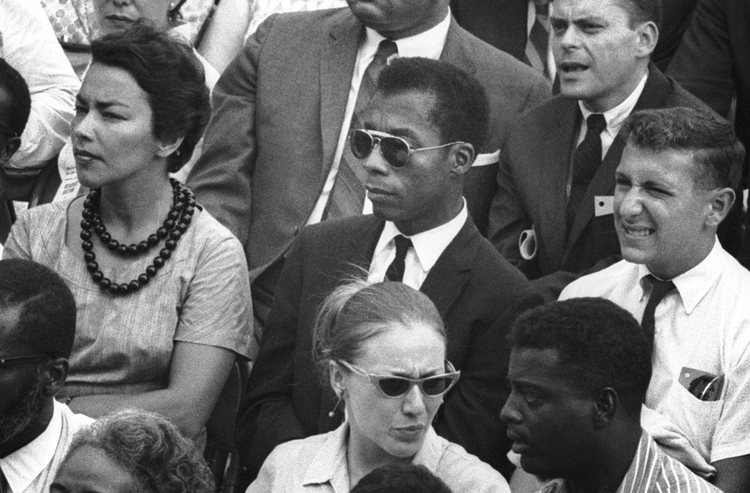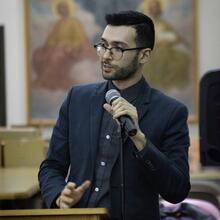In his essay “Notes of a Native Son,”James Baldwin compares his experience as an unloved stepson with his experience as a black American, noting that U.S. culture treats blacks like ugly stepchildren. The most alarming experience of racism he had was in a diner in New Jersey in 1948. He recounted a surge of rage taking over him as the waitress told him, “We don’t serve Negroes here.” He started to lose awareness of what was going on and ended up flinging a glass at her. She ducked, and it shattered a mirror on the wall across from him. As he regained consciousness and bolted out of the diner, he writes that he “saw nothing very clearly but I did see this: that my life, my real life, was in danger, and not from anything other people might do but from the hatred I carried in my own heart.”
As our country once again confronts violent racism, Baldwin’s words explore what hatred can do not only to society at large but to the individual who bears it.
Baldwin’s words explore what hatred can do not only to society at large but to the individual who bears it.
Baldwin felt this kind of hatred not just for white racists, but for his own stepfather, David Baldwin, who suffered from mental illness and was a religious fanatic. In addition to imposing his Pentecostal religion on young James, he made him feel like he was ugly. Baldwin described his loathing when looking upon him dead in his casket and how unsettled this hatred made him.
Baldwin eventually went on to become one of the most powerful voices in 20th-century American literature. His work touched on issues like sexuality, race and class in ways that were far ahead of his time. As a young man, increasingly able to recognize the correlation between the wounds inflicted by his stepfather and by racist America, Baldwin grew in his determination to fight against injustice and hatred in all of its forms.
“This fight begins, however, in the heart,” he wrote, “and it now had been laid to my charge to keep my own heart free of hatred and despair.”
The idea of covering over his wounds by hating his actual stepfather or racist U.S. culture would not satisfy him. He knew that to be truly free meant to be healed. And part of that healing would require reconciliation and striving toward unity with those who had oppressed him. Baldwin’s path toward crossing the divide required that his “enemy” be part of the healing process.
Baldwin knew that to be truly free meant to be healed.
Baldwin’s wounded relationship with his stepfather made him desperate to find role models and mentors as he was growing up. The most impressive one, perhaps, was Beauford Delaney, whom he met in Greenwich Village in 1940. Baldwin was immediately captivated by his warmth, charisma and artistic vision. One of the most striking memories Baldwin had of Delaney was of when they were walking down the street after a rainstorm and Delaney pointed out a puddle, asking him to “look.” Baldwin claimed to see nothing but water. Then Delaney asked him to look again. This time, Baldwin noticed some pools of oil swirling within the water, causing the reflection of the buildings to radiate brightly.
He experienced Delaney to be his “long-lost father” who “never gave [him] any lectures” but instead provoked him to recognize beauty within the ugliness, both internally and in the world around him. Baldwin learned to look at reality through his mentor’s gaze, going on to say that “the reality of his seeing caused me to begin to see.” In his 1964 essay Nothing Personal, a monograph that included photographs by Richard Avedon, Baldwin spoke of the “miracle of love” that begins to “take flesh” when we encounter someone who embraces our wounds and is unafraid of making themselves vulnerable to us. Delaney was not the miracle but instead helped Baldwin to be more receptive to that miracle, wherever it might come from.
Many of Baldwin’s realizations and much of the language he used are rooted in his Pentecostal upbringing. He distanced himself from the church of his childhood (and from organized religion in general) because of its moralistic and pietistic nature. Needless to say, the Christianity of his youth repelled him. It covered over the broken and needful humanity of people Christ came to save.
Ironically, it was by leaving the church that he was able to come to understand his need for salvation, for a “revealed” answer to his questions. It was Baldwin’s faithfulness to going to the depth of his wounded humanity that enabled him to recognize his need for a greater love, for a truer happiness. It was precisely this need that the slave traders who bought and sold his ancestors denied. They convinced themselves that the people they enslaved were not really humans, which enabled Jim Crow to draw an artificial line dividing brothers and sisters into “whites” and “colored,” or human and not entirely human.
Baldwin attributes the divisions in society to the widespread “blindness” to our own humanity.
When I look at the United States in 2020, rent apart and reeling, I see just how prophetic Baldwin’s words were in the beginning of Nothing Personal. Baldwin attributes this division to the widespread “blindness” to our own humanity. We are still deluding ourselves that wounds are something we should hide rather than basic realities we ought to delve into.
The range of responses stirred up by the slaying of black lives testifies to Baldwin’s warnings. We argue back and forth about who is on the right side and who is on the wrong side of these killings. We debate the best way to correct systemic injustices and whether or not the burning of cities and retaliation against police is a justifiable way to bring attention to them. Yet as I take in all of these reactions from the news and from social media, I hear Baldwin’s voice in the back of my head, asking me those fundamental, human questions.
When we skip over those questions, it becomes easier for us to convince ourselves that the “answers” are in our hands. And we become more inclined to fortify the walls that divide us from those we deem to be on the “wrong side.” Our inability to look closely at our wounds makes it unbearable to be challenged by the “other” and to accept that justice is not something that we can bring about by our own efforts.
It seemed to Baldwin that the divides between black and white, rich and poor, saved and damned, beautiful and ugly were the result of Americans’ inability to look at themselves in the mirror, at who they really are. This internal blindness has, in effect, blinded us to the humanity of the other and to our experience of reality more broadly.
Our internal blindness has, in effect, blinded us to the humanity of the other and to our experience of reality more broadly.
My first encounter with Baldwin’s unique take on racism and American culture was through the 2018 documentary “I Am Not Your Negro.” This was when I began to realize that for Baldwin, racism was the symptom of an existential or “human” disease.
Baldwin did not deny the political implications of racism; he became enthusiastically involved in politics as time went on. He became an outspoken supporter of the Student Nonviolent Coordinating Committee and attempted several times to convince Attorney General Robert F. Kennedy to take the plight of urban blacks more seriously. But what made his approach unique was that he started from the personal level.
Baldwin’s position is an echo of Jesus’ indication that social justice begins from personal conversion. Pope Francis recently commented that “the justice proposed by Jesus is not a simple set of rules applied technically but a disposition of the heart that guides those who have responsibility.” Francis emphasized that the conversion of the individual “is the only justice that generates justice!” In Baldwin’s eyes, the political injustices brought on by racism began and can only be changed from the level of one’s inner self-awareness.
Baldwin’s dedication to seeking an experience of healing for these racial wounds turned into a journey. He dedicated his life to discovering the answers to the questions that plagued him since his youth. But this journey was not an individualistic endeavor. He believed he was called to be “a witness to whence I came, where I am. Witness to what I’ve seen and the possibilities that I think I see.”
Baldwin’s position is an echo of Jesus’ indication that social justice begins from personal conversion.
His journey of making sense of his wounds was an experience he felt compelled to share with others, to provoke them to begin to look at their own woundedness and to reject the idea that we ought to mask our own vulnerability. The more we deny our own humanity, the more we become blinded to the humanity of others.
Baldwin continues in Nothing Personal to lament that we “appear to have become too timid to question what we are told. Our failure to trust one another deeply enough to be able to talk to one another has become so great that people with these questions in their hearts do not speak them.”
Baldwin attempts to help us face those rare and precious moments when existential questions inevitably rise up to the surface of our consciousness. He points to that “devastating” moment when we wake up in the middle of the night and start thinking about all the things we have to do the next day: Get up. Get dressed. Go to work. Then back home, fall asleep and do it all over again. Just going through the same cycle again and again. What is the point? Why does anything matter? Who am I and why do I even exist in the first place?
“It is a fearful speculation—or, rather, a fearful knowledge—that, one day one’s eyes will no longer look out on the world,” he wrote. “One will no longer be present at the universal morning roll call.... Sometimes, at 4 A.M., this knowledge is almost enough to force a reconciliation between oneself and all one’s pain and error.”
Baldwin indicates that we have two choices at this moment. Either we can fall back asleep and keep blindly going through the routine, never really looking at our need for meaning or for answers to those existential questions. Or we can wake up and look at ourselves in the mirror, facing our need to be infinitely, unconditionally loved.
The answer, Baldwin proposes, does not emerge in the realm of politics or law. As much as the correcting of social evils does require radically restructuring our political system, any change that does not begin on the level of the individual will be inert, at best. Nor will the answer be something one can purchase or manufacture by oneself. Instead, the only adequate answer is something from beyond ourselves, what he calls, “a miracle.”
“For, perhaps—perhaps—between now and that last day, something wonderful will happen,” Baldwin writes in Nothing Personal, “a miracle, a miracle of coherence and release.... It is the miracle of love.... [I]t is only this passionate achievement which can outlast death, which can cause life to spring from death.”










